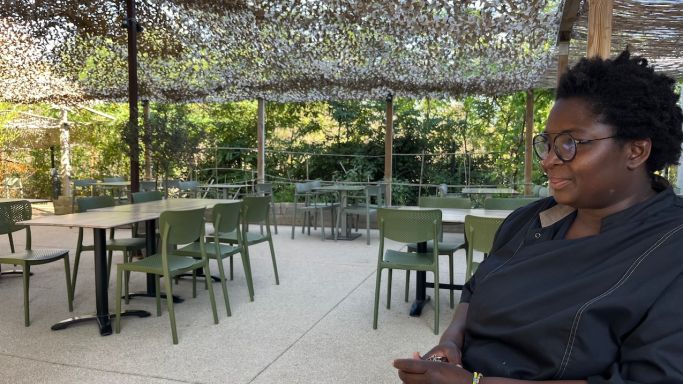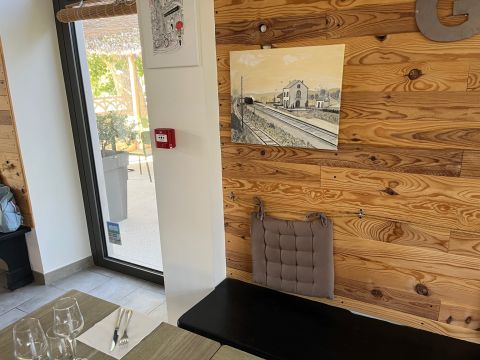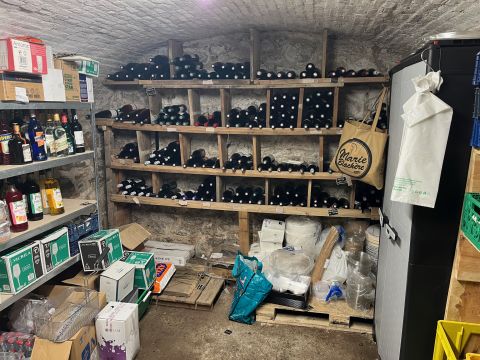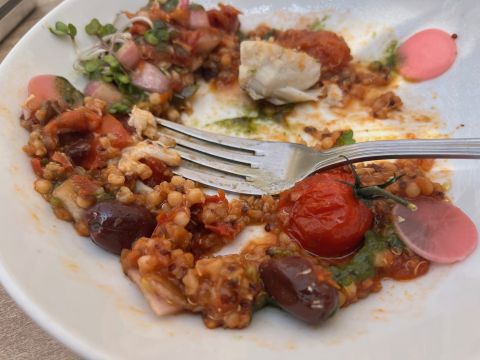The pleasure of trackside dining in the western Languedoc. Above, Tania Monnou of L’Art & Gourmand.
If you ever find yourself on the Carcassonne–Narbonne axis of the Languedoc in south-west France and would like to be well fed and well looked after in what is quite an unusual setting, head south on the RN113 that was once the main artery between the Atlantic and the Mediterranean.
About 20 minutes out of Carcassonne, past the village of Capendu, you will see a signpost on the right to Douzens. Take this road, cross the train tracks and after only a few hundred yards turn left and park under the trees. You have arrived at a building that has been for the past three years L’Art & Gourmand restaurant but which served a very different purpose for many decades before then. It was Douzens’ railway station.
How the 39-year-old couple Tania Monnou, who now runs the front of house, and her partner Olivier Henry (both are trained chefs) came to settle here is a fascinating story.
‘I was born in La Rochelle and Olivier in Strasbourg and after we met ten years ago we carried on working in kitchens around France. Olivier has family in the area, close by in Capendu where we now live with our four-year-old son Côm, and we used to come down to visit’, Monnou explained. ‘Four years ago we met the mayor of Douzens who had had the idea of turning what had been an empty railway station into some sort of cafe/restaurant and eventually we came to an agreement. The interior works extremely well. Come and have a look’, she urged, and I dutifully followed one Wednesday morning.
The interior does actually look like a purpose-built restaurant. In the far corner Henry and his assistant were already hard at work in what seems like a very modern open kitchen with tables and chairs for 30 laid up in front of it. By the entrance is a photograph of Douzens railway station in the old days that was given to them by a customer. Monnou led on and opened a door down to what is today an ideally cool wine cellar with wooden partitions in place. ‘Down here is where they used to store the coal for the trains but we have somewhat remodelled it’, she observed with a smile. ‘But it gets better’, she continued.
She led me through a storage area and out to the side of the restaurant to what they have converted into an extensive vegetable garden with tomatoes, courgettes, strawberries and many other fruits and salad leaves. ‘Like so many other chefs we aim to buy local but this area makes it easy for us. The quality of the produce here in the Languedoc is exceptional and it’s only sourcing the right kind of fish which occasionally gives Olivier a small problem.’
Then there is the outside space which is almost as large as the interior, and Monnou has worked hard to make as comfortable as possible. The netting that hangs overhead to provide shade from the glare of the Midi sun is in fact camouflage netting which the French army uses for ulterior purposes, and bamboo has been planted all around. But nothing can really prepare you for when a train goes through no more than 10 metres away, especially the Bordeaux–Marseille express.
‘There’s no hiding from the proximity of the train line’, Monnou admitted, ‘but it does provide me and my staff with a story, and that is invaluable. When customers arrive who have no idea of what this building used to be, then it’s fun to explain what used to go on here and how we have made it a useful stopping place for the 21st century.’ She smiled broadly.
Henry, it transpires, is as enthusiastic a chef as she is maitresse d’. From the €30 lunch menu, two dishes shone out: a thick piece of hake, judiciously cooked, sitting on a mound of tomatoes and orzo – an excellent combination – followed by a moist rum-and-almond gâteau Nantais with a mound of home-made vanilla ice cream.
In the evening, when we returned as a group of seven, I began with a terrine of rabbit and peas, followed this with a piece of sea trout and finished with a galette sitting on top of a mound of elegantly poached peaches and mint. We drank well and inexpensively, too: a white with lunch, a rosé and red with dinner. All were from Douzens, producers in a small village which, as a future article here will reveal, appears to have more than its fair share of ambitious winemakers.
This meal served to remind me of other memorable meals in buildings that had once been railway stations. There is the famous Restaurant de la Gare in Guewenheim in southern Alsace, with its incomparable wine list. When I was last there, we ate and drank memorably, a half each of Kientzler’s Geisberg Riesling 2001 for €26 and of Roumier’s 2002 Chambolle-Musigny for €35. That was in 2008 when a bottle of Château Margaux 1983 was a mere €300 on the list!
The Siedel family have maintained this restaurant’s standards, according to a discriminating couple of French friends who make a point of visiting the restaurant on their annual trip to the Art Basel fair relatively close by. When I asked Marc about their most recent visit, he replied, ‘We were there on 10 June. The food was fine, with asparagus and delicious fried potatoes, and the wine list is as extraordinary as ever. We had Clos St-Hune 1999 and Château Rayas 2009. We spoke a long time with the owners before we left. They are in their early seventies.’
Our meals in Douzens also brought back happy memories of a dinner in Bronte on Etna, Sicily, at the aptly named Ristorante Hosteria della Stazione, a meal I remembered as much for the food as for the wonderful building, a former station, and the view as I left. As I wrote then, ‘Walking out under the stars, I felt confused. I had never eaten so well in such an unlikely setting and I still half expected a cowboy on his horse to be waiting’ for me.
All of which prompted this thought: why had I never eaten in a former railway station in Great Britain, the country which initiated the railway revolution? I could not think of any establishments like those described above, so I asked Christian Wolmar, the leading expert on the British railway system, whether he could help. He could not. This comes after the closure of many suburban railway stations after the cuts implemented by Dr Beeching in his 1963 report. The major London railway hubs – Victoria, Liverpool Street, London Bridge, Paddington, Euston and King’s Cross – have become magnets for today’s providers of coffee, sandwiches and salads, but such formal restaurants as there are nearby – the Midland Grand, for example – tend to appeal less to their time-pressured customers.
For a good meal in a former railway station, I will willingly have to head back to the tiny village of Douzens.
L’Art & Gourmand 3 Ave des Corbières, 11700 Douzens, France; tel: +33 (0)7 60 95 26 98
Every Sunday, Nick writes about restaurants. To stay abreast of his reviews, sign up for our weekly newsletter.





